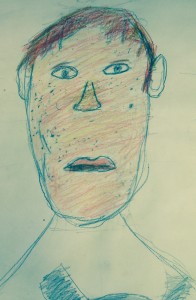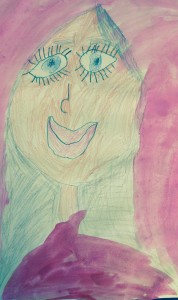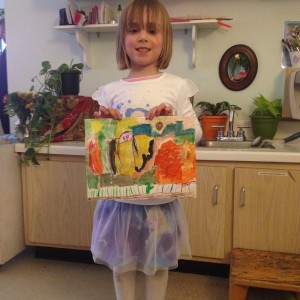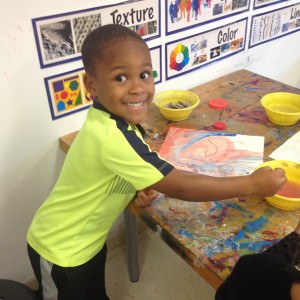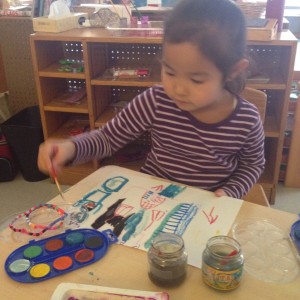Greensboro Montessori School's Upper School students took a leading role in Friday's Earth Day celebration. Upper Elementary students kicked off the morning with readings of original poetry and Spanish. After the program (which we shared live on Facebook), Junior High students hosted Lower and Upper Elementary students at eight different different stations set up on the Athletic Field. Each station featured an activity to to raise awareness for Earth Day, including ideas for recycling, composting, and even limiting our waste. Primary students enjoyed a lesson with our environmental educators, Chelsi Crawford and Sara Stratton. Toddler students took everything in from their shaded mats under the trees, just steps away from their play yards.
The original poetry shared by our Upper Elementary students highlights our integrated curriculum. Students combine their skills in English, Spanish, creative writing, science, environmental education, public speaking, and leadership all at once. We are honored to publish their work for all to experience.
Redbud Tree
Lydia, Sixth Grade
The Eastern redbud tree, purple blossoms in early spring. Small beacons of colour adorn the dull, monochromatic landscape. Bursts that spring is just around the corner.
As the blossoms begin to fade, they get swept away by the gusts of wind that spring brings. Petite purple petals pressed onto the ground as they get trampled by tiny feet. But not all is lost, leaves that are a deep crimson, like garnet, or a sharp, zesty lime the size of a hand unfurl. The leaves are shaped like spades. Desperately trying to hold onto their branches by their paper-thin stems. Through treacherous storms they hold on, not falling yet, for the leaves have roots of their own.
The redbud tree is eternally stretching, reaching its roots through the mycelium and soil, while the branches are competing for the warm rays of sunlight. The uneasy cottontail rests by the roots of the tree, protected by the lush canopy from the hungry hawks’ view.
During autumn, the leaves of the redbud tree glow orange, like a campfire. Only turning into a bonfire as the chorus of the other deciduous trees chime in in the early November. Then, the redbud tree goes to sleep as the long, cold winter days begin.
Día de la Tierra Upper Elementary Group A
- Debemos cuidar la Tierra porque es el único planeta que temenos.
- Debemos cuidar la Tierra porque es nuestra casa y nuestro hogar.
- Debemos cuidar la Tierra porque vivimos en ella.
- Debemos cuidar la Tierra porque hay animales, árboles, océanos y más.
- Debemos cuidar la Tierra porque es la casa para todos los tipos de vidas.
- Debemos cuidar la Tierra porque nos da comida.
- Debemos cuidar la Tierra porque es la casa de todos.
- Debemos cuidar la Tierra porque es muy bonita. Los humanos debemos comprender que no se debe hacer daño a la Tierra.
- Debemos cuidar la Tierra porque o si no nos extinguieremos.
- Debemos cuidar la tierra porque es nuestra protectora y nuestro hogar.
sphagnum
Tanner, Fourth Grade
The sphagnums dance in the rain like an umbrella being twirled. The sphagnums dance in the rain on the mother tree. The sphagnums dance in the rain in the rainforest. The sphagnums dance in the rain under the shade. The sphagnums dance in the rain and the damp mother tree is playing her music. The sphagnums dance in the rain, their spore capsules open up and the spores fly away. The sphagnums dance in the rain as the 10,000 ancestors watch them. The sphagnum dances in the rain, the calm green color is shimmering on as the rain falls on them, the sphagnums dance in the rain; they have no roots, stems, leaves or seeds. The sphagnums dance in the rain, they can grow until they run out of room. The sphagnums dance in the rain in their fuzzy soft coats. The sphagnums dance in the rain. They are used for medicine to save peoples lives. The sphagnums dance in the rain; they get picked and re-planted to make a garden look nicer. The sphagnums dance in the rain.
Within the three-year cycle of Lower Elementary (first through third grades), students and teachers spend one year studying the fundamental needs of humans. This theme is woven throughout their curriculum and students embark on relevant research projects providing purpose and context for their learning. Over the year, the students learn why food, water, shelter, clothing, art, and community are necessary for humanity and how these needs have remained consistent throughout our time on Earth.
One of the ways our students share their growing knowledge of human civilization, and our most basic needs, is through their Festival of Light presentation. Students read the book “Celebrations Of Light : A Year of Holidays Around the World” by Nancy Luenn. The book is a springboard to research projects centered on 12 countries and the light-themed cultural celebrations that both define and unite them. It provides exposure to the diversity of our world while simultaneously highlighting how light brings people together.
Students form teams, each taking one of the 12 countries and its respective celebration. From there, they delve into the history of the country, its culture, and the celebration. They study some of their nation’s accomplishments, art, food, geography, religion, storytelling, traditions, and writings. All of this research prepares them to participate in Greensboro Montessori School’s triennial Festival of Light.
The Festival of Light features all of our Lower Elementary students in an evening presentation for their families, faculty, and members of the greater school community. Each of the 12 teams prepares a narrative on their country’s celebration of light. The celebrations include:
- New Year's Eve in Brazil
- The Chinese New Year
- The Lantern Parade (Eid al-Fitr) in Sierra Leone
- Lichtmesdag in Luxembourg
- Buddha's birthday in Korea
- Bon Matsuri in Japan
- Diwali in India
- Loy Krathong in Thailand
- Hanukkah in Israel
- Luciadagen in Sweden
- Christmas in the United States
- Las Posadas in Mexico
- Kwanzaa in the United States
The presentation itself anchors our students’ research in purpose and provides these first, second, and third graders with a nurturing and challenging academic experience. Surrounded by their families, friends, and teachers, students share their knowledge in a safe space where they will be celebrated for their work. The Festival of Light also challenges our students by pushing them to develop and expand their public speaking and presentation skills in new ways.
When the last celebration has been presented, the audience chairs have been put away, and the families have left for home, there’s no doubt our students have been part of an educational experience. One that has taught them about the fundamental needs of humans, community, teamwork, and so much more.
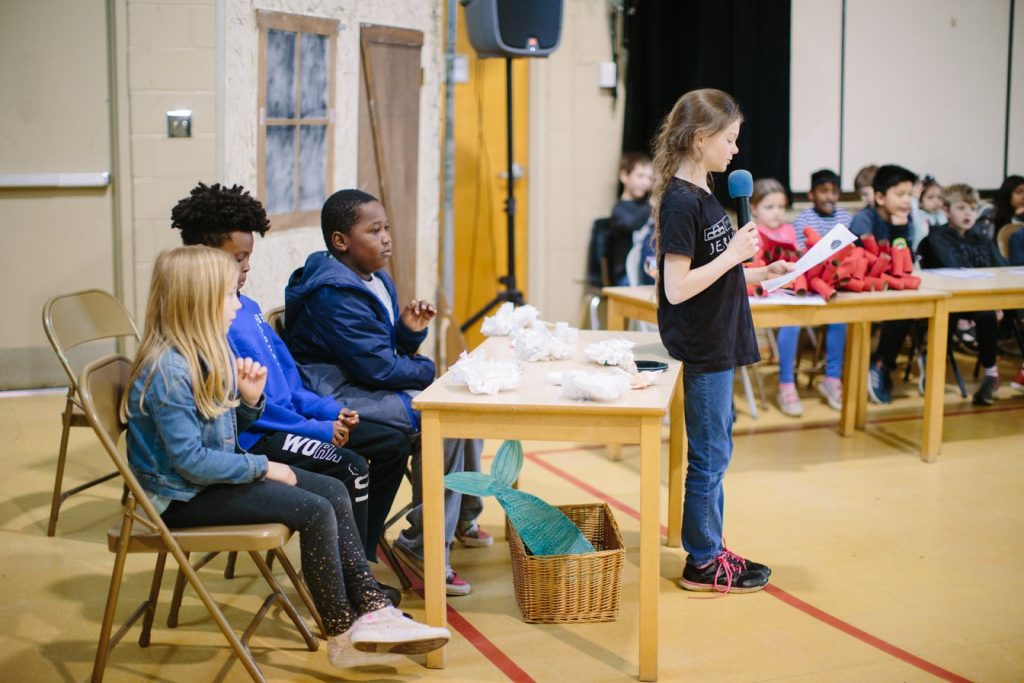
Lower Elementary students rehearse for Greensboro Montessori School's triennial Festival of Light.
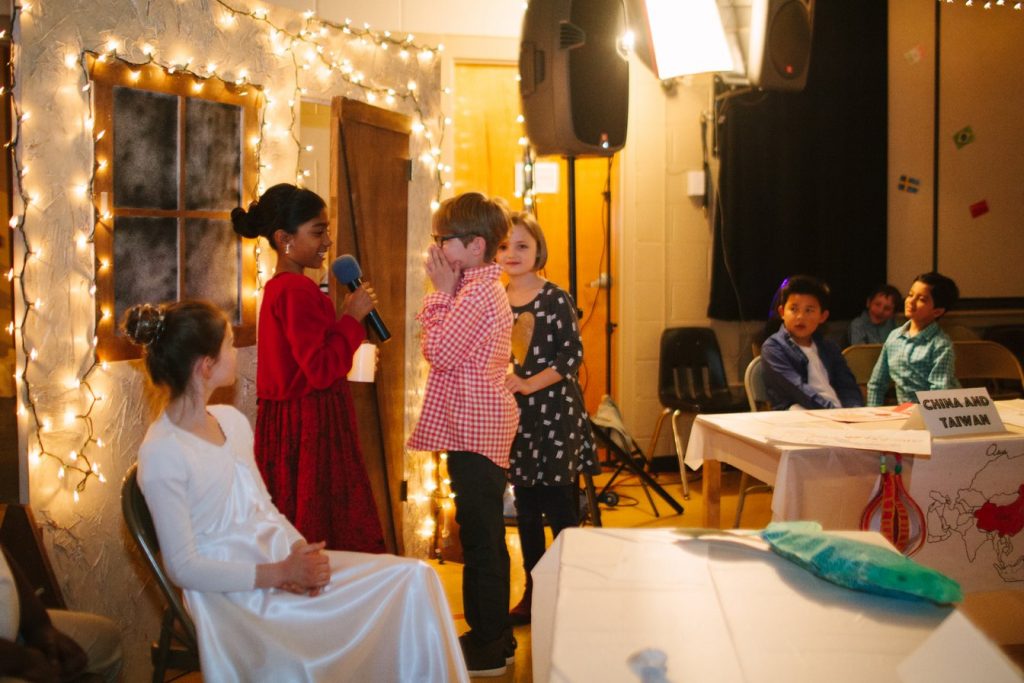
Students reenact the Candlemas tradition of going door to door singing for a candy treat.
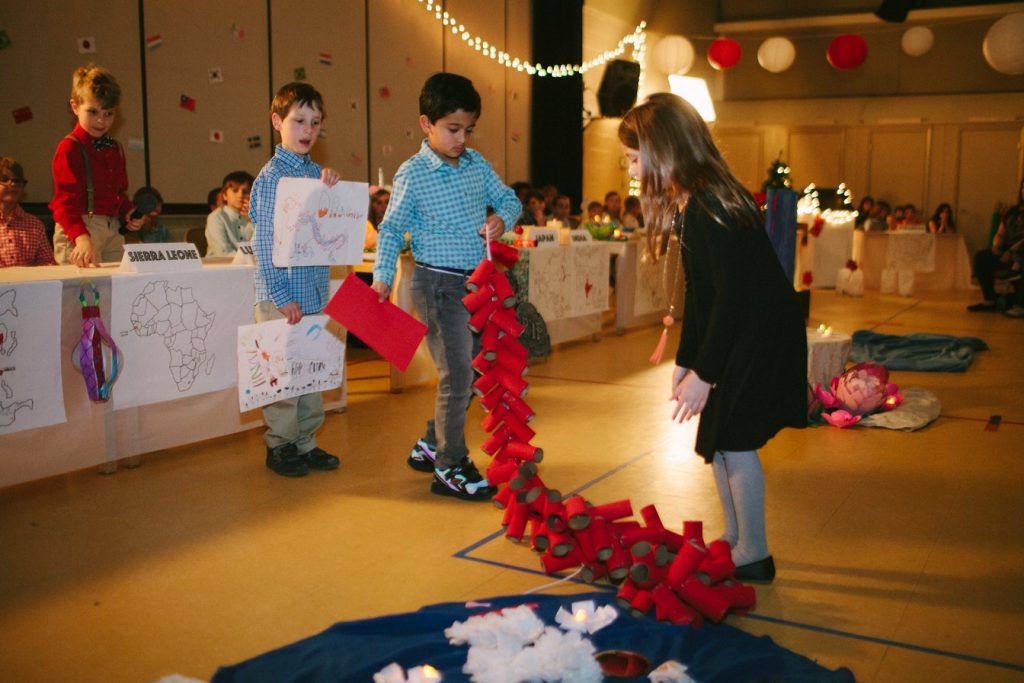
Students present the Chinese New Year, which is celebrated in China and Taiwan.
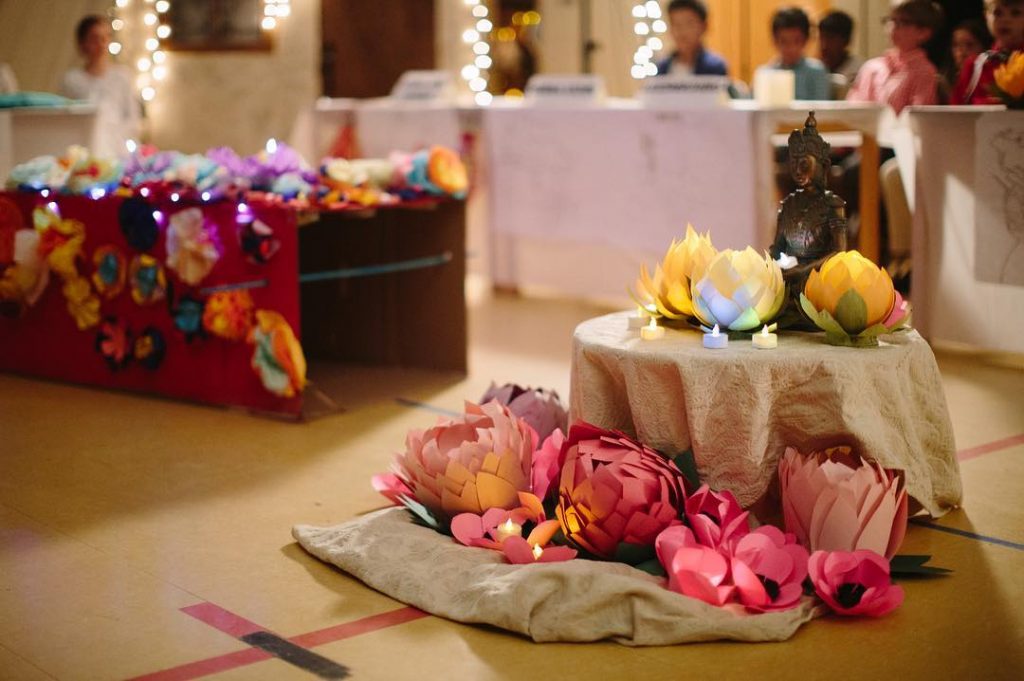
Pictured to the left is a student-made float for the Lantern Parade celebrating Eid al-Fitr in Sierra Leone. The celebration of Buddha's birthday in Korea is pictured to the right.
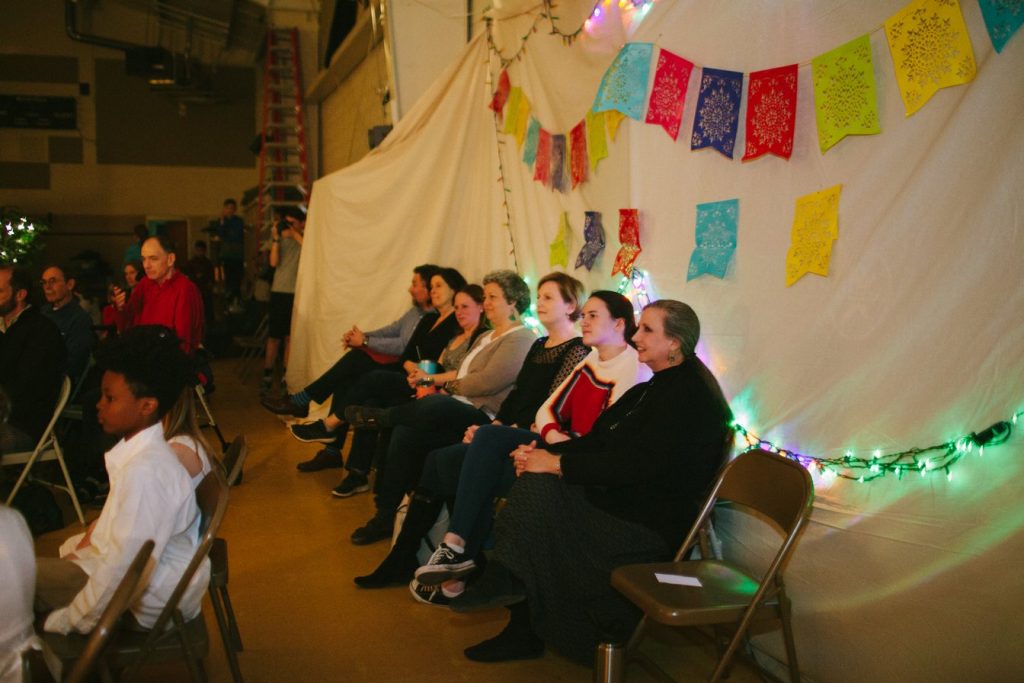
Here are the faculty, off to the side, letting the students take the lead in presenting their student research.

Students present the menorah and the lighting of the candles for Hanukkah in Israel.
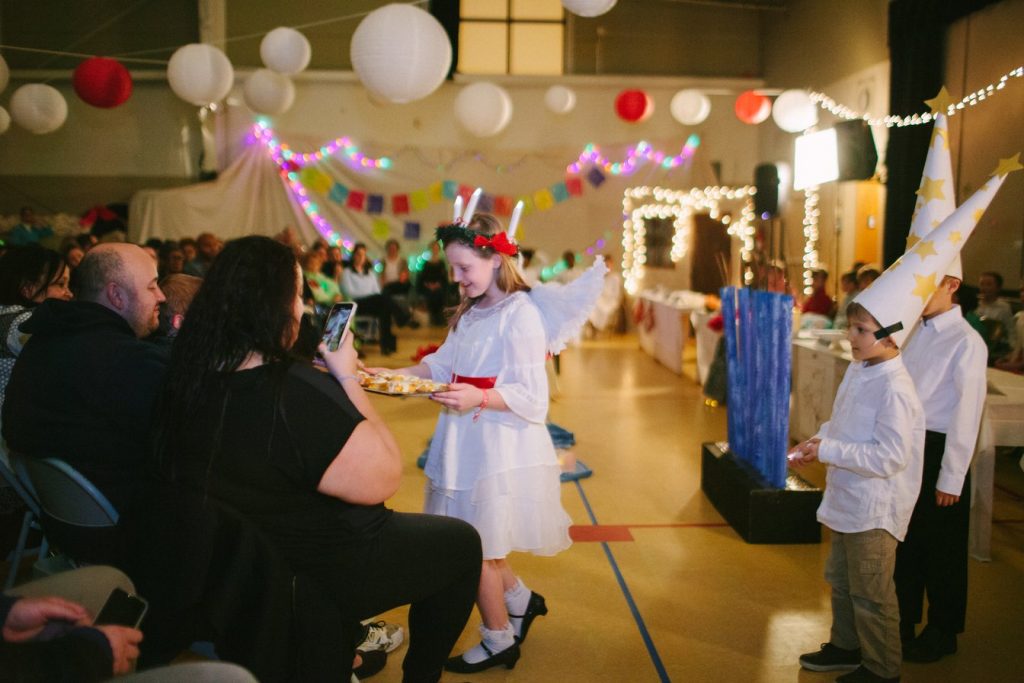
Luciadagen, or Lucia's Day, in Sweden, involves children dressing in all white and leading a procession while also handing out saffron buns.
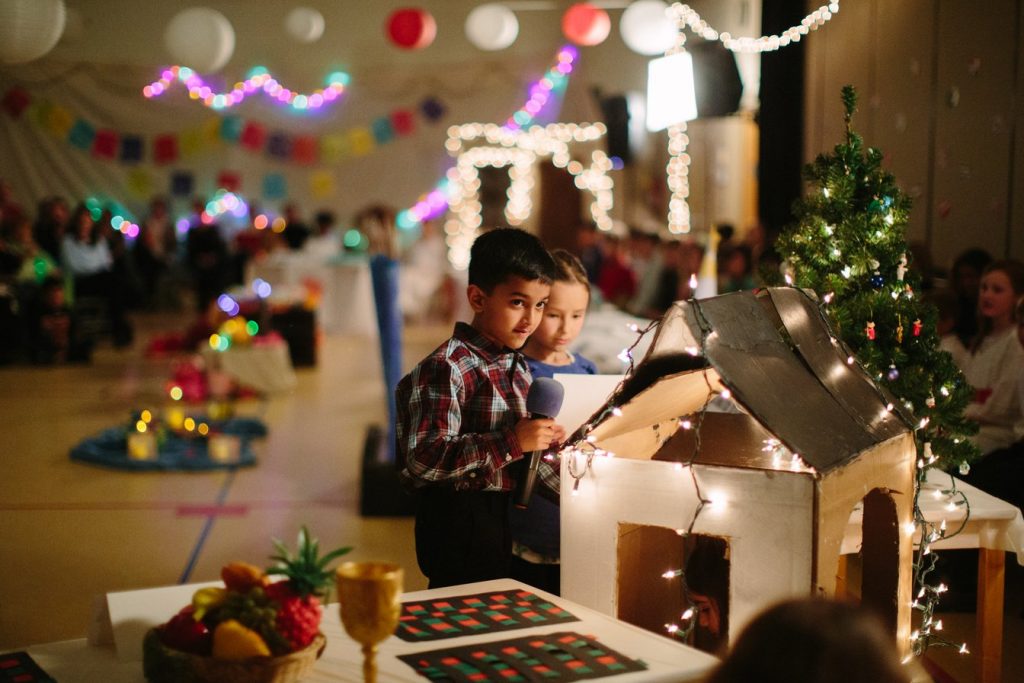
Las Posadas is a Christmas tradition from Mexico and is a reenactment of Mary and Joseph's search for the inn ("la posada") on Christmas Eve.

A third-grade student leads her peers in the final presentation of the night, a secular version of the song "This Little Light of Mine."
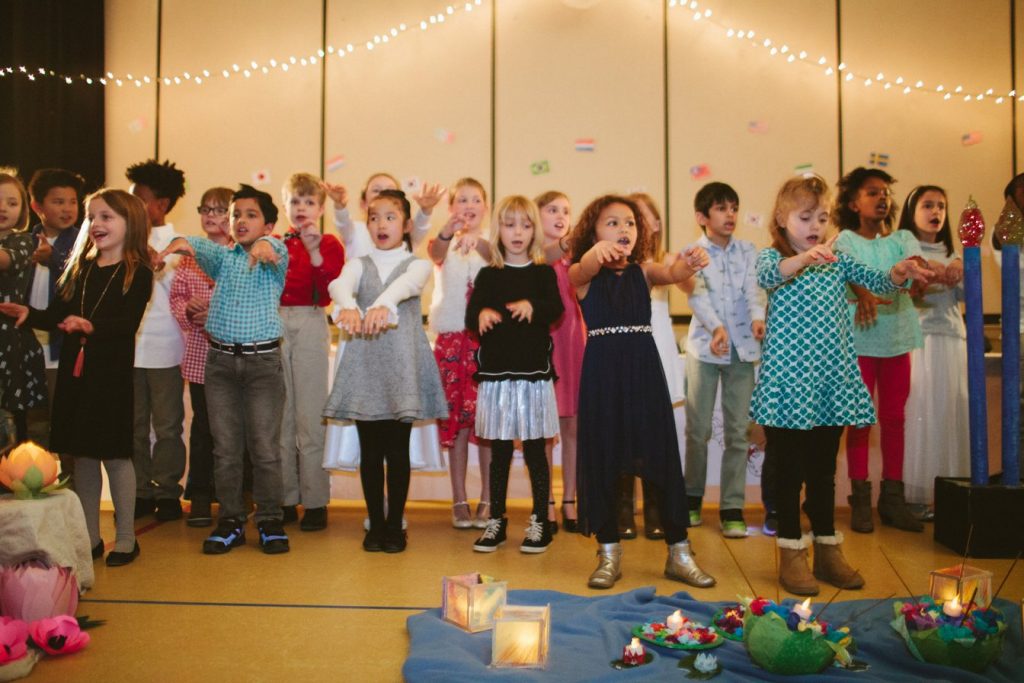
Students close their presentation by singing a secular version of "This Little Light of Mine."
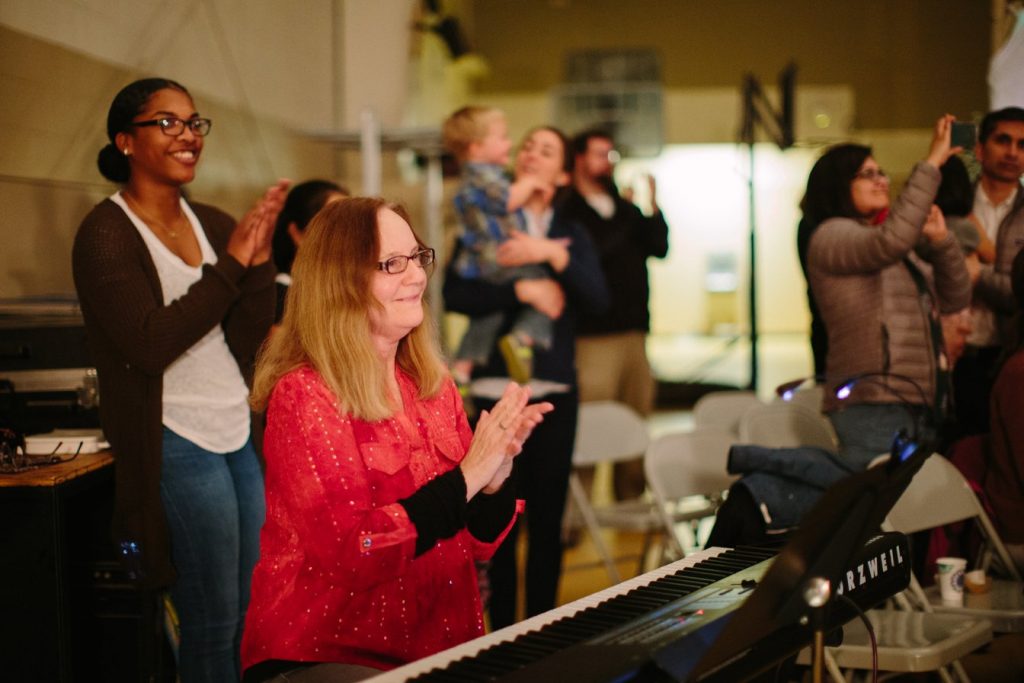
The Festival of Light comes to an end, and the students enjoy tremendous applause from the audience.
Greensboro Montessori School's Junior High student council members usually plan three dance parties a year, one each in the fall, winter, and spring. Whether an upcoming dance is your child's first or they have attended these kinds of functions before, we have some details to help you plan ahead.
When: Greensboro Montessori School dances are on a Friday night from 7 to 9:30 p.m.
Where: Dances are hosted in Greensboro Montessori School's Gymnasium
Who: Attendance is limited to currently enrolled students in grades six through nine. In general, students may not bring guests from other schools. In some instances, Greensboro Montessori School has invited other independent schools in the Independent School League to attend dances, but this is the exception to the rule.
Attire: Students may choose to dress up or wear regular clothing. Attire must follow Greensboro Montessori School's dress code. We ask all attendees to wear soft-soled shoes that will not scuff or leave marks on the gym floor.
Chaperones: All dances are chaperoned by faculty and staff from Greensboro Montessori School. On the night of the dance, parents may drop-off their child at the Gymnasium entrance at 7 p.m. and return at 9:30 p.m. when the dance is over. The School always provides the name and cell phone number of at least one chaperone in a personal email to parents.
Cell phones: Students are permitted to bring cell phones to dances.
Entrance Fee: Students pay $5 cash at the door to attend dances.
Music: All Greensboro Montessori School dances have a DJ who is a current student. They develop a playlist based on student requests and submit this playlist for review by their faculty advisor. The faculty advisor reviews the list for content and language and approves only those songs which are age appropriate.
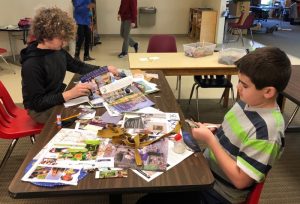 What do you love in the world and think is worth preserving?
What do you love in the world and think is worth preserving?
Upper Elementary students wrestled with this important question during their class project for the Green and White Bash silent auction. My daughter, Stella, is a student in the Upper Elementary classroom, and I was privileged to assist the children in transforming two blank puzzles into a lively mixed media college. Since the Bash’s theme was “sustaining our future” through the funding of student scholarships and staff professional development, I thought it would be fitting for the class project to address this idea of sustainability. So, I asked each student to design a single puzzle piece that identified their own personal junction of love and preservation. All the pieces joined together to form a single, unified collage.
The project turned out to be both intellectually and artistically challenging for the class. Some of the students needed clarification on the question and took extra care to reflect on the conceptual differences among sustainability, preservation, and conservation. Others thought of multiple ideas and found it hard to choose a single focus for their piece. They would sit in thoughtful silence, rifle through magazines for inspiration, or simply run off to do something else, planning to return later. For other children, the process was easier and they settled into their work instantly. Regardless of how quickly their work progressed, it was humbling to witness the moment when each child’s idea clicked into place. You could sense the wave of clarity and purpose wash over them as they set themselves to task. They would sift through the huge pile of assorted collage papers and magazines and dig through buttons, cork, sequins, pom pom balls, threads, beads, and other odds and ends to find the perfect color, texture, or imagery to convey their idea.
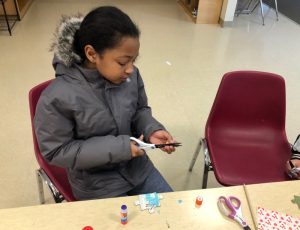 The students’ approaches to composition varied as dramatically as their themes. Some enjoyed working very flat, while others preferred a more 3D composition. Some students chose clipped images and text, while others wanted to incorporate their own drawings. Some designed beautiful miniature scenes of forests and picnics, while others worked more conceptually and built up layers of interest. Each piece was transformed into a unique and carefully crafted work of art.
The students’ approaches to composition varied as dramatically as their themes. Some enjoyed working very flat, while others preferred a more 3D composition. Some students chose clipped images and text, while others wanted to incorporate their own drawings. Some designed beautiful miniature scenes of forests and picnics, while others worked more conceptually and built up layers of interest. Each piece was transformed into a unique and carefully crafted work of art.
After the last student finished, I packed up all of the supplies and took everything home to (literally) put the pieces together. As I assembled the individual pieces into a finished collage, I was amazed by how well the variety of themes and designs worked together. Thirty-seven distinct responses to a single question had morphed into a microcosm of our beautiful, crazy modern world. Elements of nature (birds, oceans, trees) wove through interpretations of social life (family, friends, holidays) and modern living (technology, medicine, Disney). The Upper Elementary class project about sustainability had become an ecosystem of gratitude and hope for the future, where nature merges seamlessly with people, technology, and traditions: very much like a day at Greensboro Montessori School!
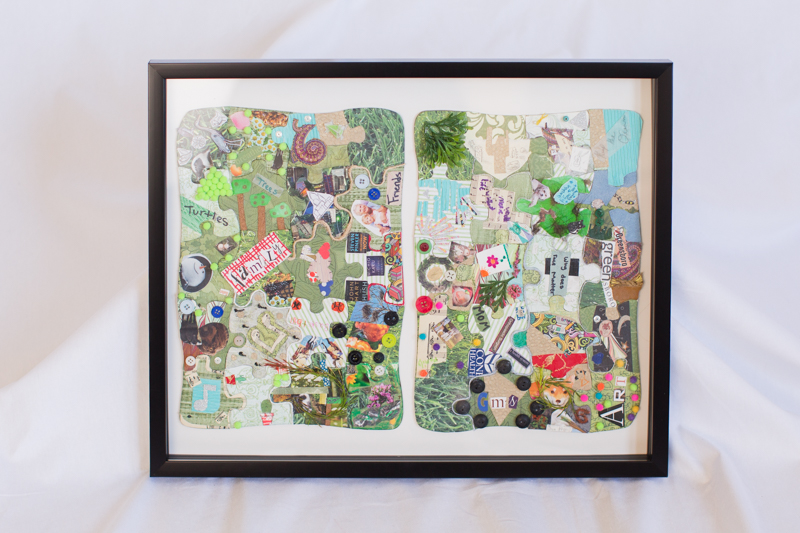
 About the Author
About the Author
Gina Pruette is a parent and regular substitute teacher at Greensboro Montessori School. In addition to her commitment to the School, Gina is an active volunteer within the greater Piedmont Triad community where she leverages her expertise in marketing and events planning, fundraising, and tech solutions to further the missions of various nonprofit organizations. Gina recently completed Racial Equity Training through the Racial Equity Institute to strengthen work with diverse populations, and she holds a bachelor of arts from the University of Pennsylvania.
Greensboro Montessori School's mission is to nurture children to be creative, eager learners as they discover their full potential and become responsible, global citizens.
We recently sat down with Upper School Faculty member, Jonathan McLean, to learn more about Greensboro Montessori School's Junior High Music Ensemble. Here's an edited transcript of our conversation.
Q: What exactly is Music Ensemble?
A: We have a lot of students who want to play a lot of different things or perform a lot of different [types] of music ... anyone from somebody taking violin, to taking piano, to taking singing lessons, to just hanging out at home banging around on the piano. To follow the child - and the best thing for each child - I've found is the Music Ensemble, which is just a big band.
Q: Is Music Ensemble part of students' regular coursework, or is it an elective?
A: The closest thing it's to is an elective. Certain people are required to be in it. If [a student is in] my Creative Labs class and they are always [applying] for positions for composers or being in the band, then yes, it's a requirement they have to be in Music Ensemble. They give up one of their independent studies, which makes it like an elective, and come in [the studio] and rehearse.
Q: How often do you rehearse?
A: One class block every week, which is an hour and fifteen minutes, which is barely enough. But it is Wednesdays. We loose [lots of Fridays and Mondays] every year for [teacher workdays] and national holidays. That's why I put it on Wednesday, so we lose fewer of them. We also have dress rehearsals and sound check rehearsals before any show, [which would] be on a Saturday or Sunday usually, or right after school.
Q: Who can participate in Music Ensemble?
A: Anybody that's already had at least a year’s worth of lessons on a instrument, because Music Ensemble is not for me to teach you how to play an instrument. Creative Labs, actually, is [when] I can spend some time showing a student some stuff about how to play an instrument and then get a student hooked up with an after-school or out-of-school teacher. [Music Ensemble] is an advanced music experience, and the student needs to have already made a commitment to learning an instrument. Vocalists are taking voice lessons, and some have also taken lessons on piano.
Q: Are your vocalists also taking voice lessons?
A: One, two, three. Three of them are. One of them is not. Two of them have taken lessons on piano and have switched to vocals. Once you learn an instrument, particularly piano (because if you go off to music school everybody has to take Piano 101, it's like English Composition 101 to be a writer), you can play pretty much anything.
Q: What is the age range of your current Music Ensemble?
A: 12 through 15, [but we currently have a guest drummer] who is in fifth grade. The [typical] grades are seventh to ninth ... I invited him [to join] for two reasons. One, he's a student of mine, and he's highly advanced for his age. He could play in any band and make money right now if he wanted to. He practices with me once per week and also at home. [Two,] all my drummers graduated. It was an advantageous moment.
Q: What is the single greatest lesson your students take away from working in Music Ensemble?
A: That’s easy. Working in a band is working in a group. When you do group projects in the classroom, how do you assess how much each person is carrying their weight if it's an outside project? We don't know how to do that right now. In class though, it's a little easier ... but in a band, if you are not carrying your weight, everybody knows it. There is no calling somebody out and being unfair and them saying, "No, I know my part." No, you don't, because we have to stop because [someone's] part is wrong, and I don't mean that in a harsh way, it's just one for one, like math. It's either right or wrong. It's either in tune, on rhythm and in the right spot, or it's not. That's the single most important lesson: you cannot hide in a group.
Q: How long have you been teaching Music Ensemble?
A: Music was one of the first things I did when I got to Greensboro Montessori School [in 2002]. The middle schoolers were revolting against the traditional class where students are learning music on recorders playing from the same book I used when I was in Junior High. You have to do something current for adolescents to get engaged. So when you immediately say the word “band,” they want to play.
Q: What have you learned teaching Music Ensemble?
A: The first lesson I learned was the drawback to individual lessons. I think that all people who [teach] individual lessons should have some sort of network where they get their students together to play in an ensemble or a band. I would get a full band together [at Greensboro Montessori School] and each student may have had 2 to 3 years of lessons on their given instrument, and we'd start the song, and we'd play through it, and it would just be cacophonous and terrible. If you just pulled [each musician] out magically and just listened to them, they would nail the song, but they had been taught in a vacuum. As long [as a student thinks they're] playing the song correctly, they're not even tuning in to the other members of the group. So that goes back to the step above learning to work in a group. One, you can tell who is not carrying their weight, but two, its awful, its not pleasant. To teach you to tune into that goes into all the other stuff about brain development and mathematics and what music does to your brain.
Q: What do students new to Music Ensemble need to learn?
A: They need to start listening to each other. It is self awareness and it's being aware of other people, and doing that thing Miles Davis said where everybody pushes and pulls each other. If somebody's lagging behind, it may be because they are having a hard time with a song, so the band has to tune into it, be a team, and slow down a little bit. You can get on them afterwards, like "why were you playing that so slow," but [during] a performance you support your team. But also, it may be, as they get the hang of it, somebody wants to pull the song back, and that sets the mood. Maybe someone wants to push it a little bit, but that's how musicians interact with each other.
Q: What is the most important thing you see your students do in Music Ensemble?
A: All the brain development that goes on after they learn the basics of working in a group, then to listen to each other, and then to get into it [with each other]. What I know as a performer and an entertainer is if you only have one person or 10000 people watching you, if the audience sees that [members of the band are] just up there doing [their] individual jobs, it's going to be apparent to the audience. And even if [the music] is in tune and played well, it doesn’t come together. There is a gestalt that happens when you are into your music, and I think thats the hardest thing to teach the kids to do, because at this age, kids get freaked out when they think people are watching them, and you know what I've learned from sports, it's not their parents watching them. It's their peers. That’s one of their biggest challenges they have - to perform. They don’t want to be awkward, they don’t want to play badly, they don’t want to seem stiff in front of their friends ... which actually, usually causes them to stiffen up.
Q: And where they are as adolescents, that’s an important factor to them, is what their peers think of them?
A: It is at the top of the list according to the best brain research and social and emotional research we have. They literally feel like they're going to die when they're not around their friends. So when their friends are in front of them, they cannot “mess up” in front of them. It's enormous pressure. That's a whole thing that doesn't even affect me. You know, I get nervous before I play, but once I start playing, I settle in. But these guys, that’s a real developmental thing for them to settle into that [and to learn to work through that pressure]. It will hopefully pay off when they get in front of people to present as an individual. Even if [these students] don't go on to be musicians, they will continue to feel comfortable ... presenting themselves, whether its for a college application, a job application, or giving a speech.
Q: As we wrap up our interview, do you have any final thoughts?
A: I am proud of fighting [for music and the arts] as an equal subject to math, science, and language, and I have teammates that have always supported me on that. Now I have a subject called Creative Labs which happens to be music, art, design, and anything like that, but that’s where the 21st century skills are going ... Every day you're getting music and every day you're getting art, which is what the [students] get here. It is equal across the board, but it does take a team that supports that and realizes that. I think that's something vitally different that we do here at Greensboro Montessori School.
We recently began a discussion on the quintessential similarities between computational thinking and the Montessori method. The three-part blog series is inspired by a recent New York Times article by Laura Pappano entitled “Learning to Think Like a Computer.” In our first post, we explained how even the simplest of Montessori materials teaches computational thinking skills. In this second installment, we highlight how the Montessori approach to education develops computational thinking within students.
We met with Jonathan McLean to talk about his semester-long assignment in the Middle School’s Creative Labs course. Like all classes in the Montessori curriculum, this visual and performing arts class integrates subject matter from other areas of study. More specifically, Jonathan is weaving together STEM (Science, Technology Engineering and Math) and Art History through a complex science fiction role-playing game involving student-built robots and drones. To make sense of the story and succeed in the game, Jonathan’s students must employ computational thinking skills.
Just what are these skills? In her New York Times article, Laura Papanno says they are “recognizing patterns and sequences, creating algorithms, devising tests for finding and fixing errors, reducing the general to the precise and expanding the precise to the general.”
Our middle school students are flexing all these mental muscles in a battle royale between the Drones and the Bots, the only remaining cultures in the elaborate story guiding this semester’s coursework. The setting is such: The Earth has overheated making it inhabitable for organic life. Only two warring cultures, Bots and Drones remain, but neither are safe. Volcanic activity threatens the Bots on land and atmospheric change jeopardizes the Drones in air. The Bots and Drones must appeal to an Alien culture to save them, and it just so happens the Aliens have tremendous reverence for the visual arts. As the Bots and Drones compete for the Aliens’ benevolence, they must do so with aesthetically appealing design and decoration which aligns with the Aliens’ favorite artistic movements.
As the facilitator, Jonathan plays the role of the Alien culture. The students are divided into multi-age teams aligned with either the Bot or Drone culture. Jonathan gives the students data sets with which to design, build and operate their Bots and Drones. The teams consist of students in the various rolls such as officer, designer, engineer and pilot. As the students receive, process and make sense of the data they receive, they must adapt to survive. Whether either or both cultures escape the Earth will be determined in a three-hour Bot versus Drone showdown next week. The teams’ performances are the students’ final exam for the class (and Jonathan has a surprise finale planned for the students if they find a win-win solution for the Bots and the Drones).
Rather than dictate or force rote memorization upon their students, Montessori teachers educate through integrated experiences. Jonathan has created a fictional and engaging theme to provide a framework in which the students are able to apply real-world skills. Students are absorbing data from multiple sources to identify problems, understand the scope of the problems and develop and test solutions. Additionally, Jonathan is purposefully withholding information forcing the students to uncover new information and draw conclusion on their own. Harkening back to Laura Pappano’s words about computational thinking: “Concealing layers of information makes it possible to get at the intersections of things, improving aspects of a complicated system without understanding and grappling with each part. Abstraction allows advances without redesigning from scratch.”
If all of this sounds like a lot of fun, it is. Our middle school students are learning science, technology, engineering and math in their visual and performing arts class. If a student loves art, he can pursue this interest through the final appearance of his Drone, but he must also ensure aesthetic enhancement doesn’t impact physical performance. On the contrary, if a student loves engineering, she can fuel her curiosity through building her Bot, but the structure must accommodate one of the Aliens’ preferred art movements, for instance, Cubism.
In most schools throughout the country, these two students couldn’t thrive in the same class, but the Montessori method demands they both succeed by allowing them to pursue their passions through integrated curriculum and independent study. No single class takes place in a vacuum of learning, and students must carry their knowledge and experiences from one class to another. Ultimately, it’s learning how to think (like computational thinking skills), versus what to think which prepares these students for a lifetime of achievement.
A professional artist and entrepreneur in her own right, Madeline Gallucci is a nothing less than a rising star in the Kansas City art scene.
After graduating from Greensboro Montessori School in 2004 and Weaver Academy in 2008, Madeline received her Bachelor of Fine Arts from the Kansas City Art Institute in 2012. Shortly thereafter, she landed the Charlotte Street Foundation Urban Culture Project Studio Residency. Two years later she was named Artist-in-Residence at Hotel Phillips, a historic hotel in the center of the city. The 12-month program showcased Madeline and her work in a large storefront window space on the first floor of the hotel that doubled as her studio. Her artwork was also translated into textile patterns used in interior design elements—such as bedding, upholstery, pillows, curtains and wall art—in some of the guest rooms. She also conducted numerous workshops, studio tours and artist lectures. Madeline was only the fourth artist to be selected for this elite residency program and notes: “It was a tremendous opportunity to develop my public speaking skills. In essence, I was acting as an ambassador for abstract art.”
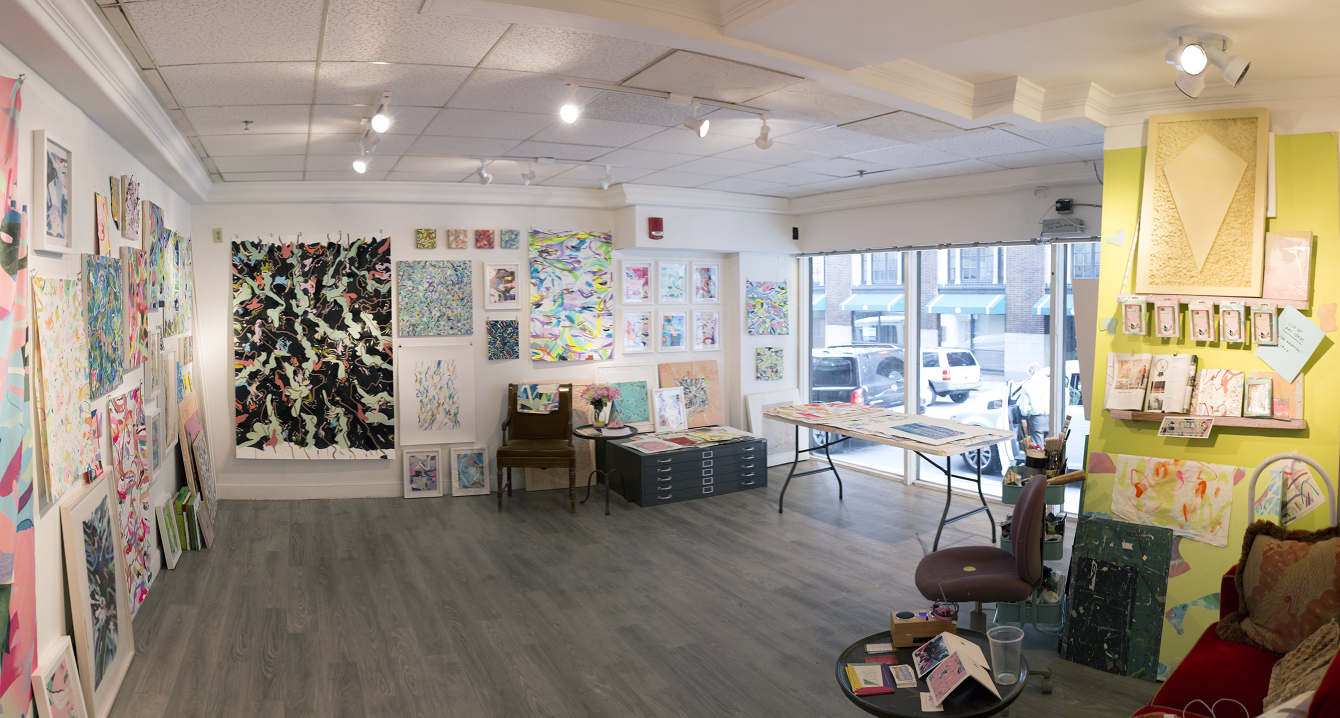
Madeline Galluci's studio gallery at Hotel Phillips. The program offered an experimental and collaborative opportunity for Madeline, the hotel, guests from all over the world, and the local Kansas City community.
As if two residencies weren’t enough to celebrate, Madeline was named one of three Charlotte Street Foundation Visual Artist Award Fellows in 2016. The award recipients were selected through a competitive process involving in-person interviews, presentations and studio visits by a panel of renowned and qualified arts professionals, and culminated in a four month exhibition that concluded in January 2017 at the Kemper Museum of Contemporary Art, Crossroads location. She also received a $10,000 unrestricted grant to support her work as an emerging contemporary artist. Madeline described this exhibition as a turning point in her life and her career. As a result of that award, she sought representation by a professional firm, Weinberger Fine Art in Kansas City, Missouri.
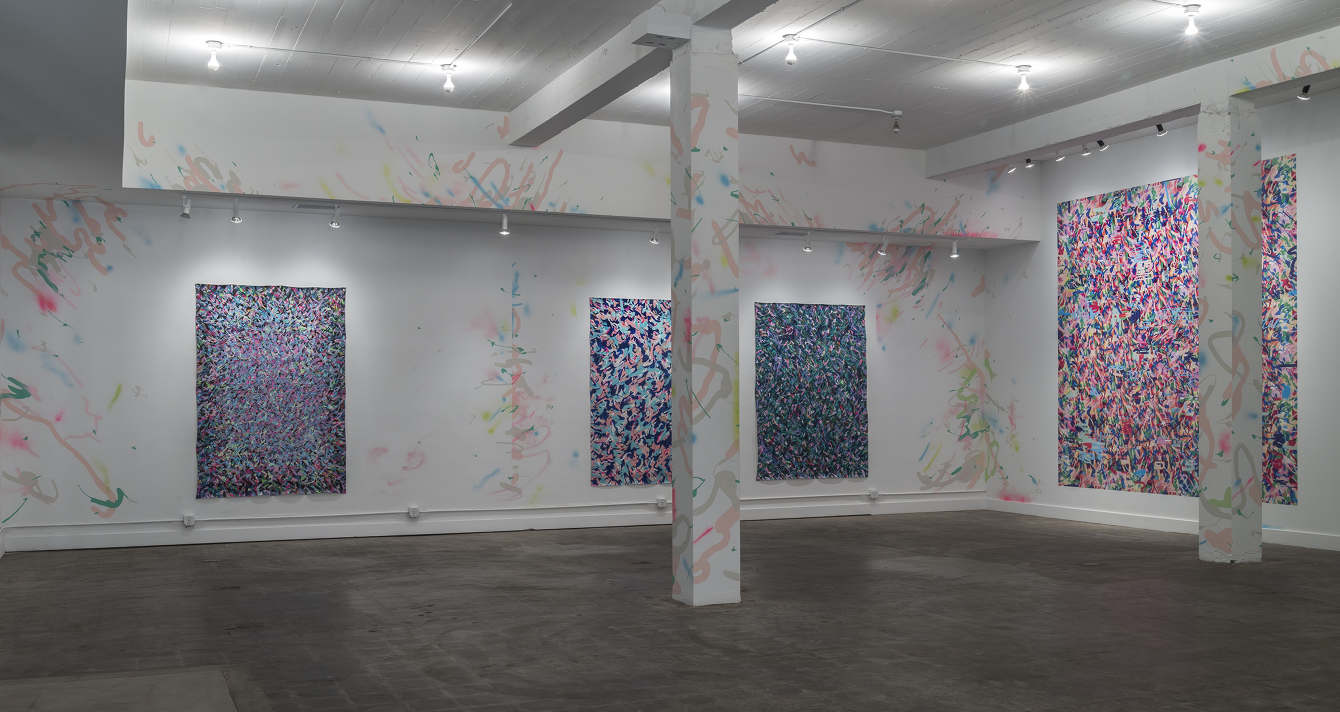
Madeline's work while on display at the 2016 Charlotte Street Foundation Visual Artist Awards Exhibition at the Crossroads location of the Kemper Museum of Contemporary Art. Photo by Misha Kligman.
When asked to describe her work, Madeline says, “My work is driven by color. Right now, I am playing with the combination of fluorescent colors together with colors found in nature. My work is also very whimsical. I am fascinated by camouflage culture. If the purpose of camouflage is to help something blend in to its environment, what happens when you take that pattern out if its natural environment. How does it blend in or stand out? I think of the trend of pink camouflage."
Beyond the borders of Kansas City, Madeline has also shown nationally at IDIO Gallery in Brooklyn, New York; Rebekah Templeton in Philadelphia, Pennsylvania; Skylab Gallery in Columbus, Ohio; and Terrault Contemporary in Baltimore, Maryland. Her newest work is currently on display in an exhibit entitled “Habitual Observations” at Weinberger Fine Art.
In addition to pursuing her professional goals through a fine art studio track, Madeline shared that she is also realizing her drive to become an arts administrator. Since 2014, she has worked as a co-director of Front/Space, a storefront apartment in downtown Kansas City that has been repurposed for non-commercial exhibits, performances, forums, research and publishing projects.
As co-director of the gallery, Madeline loves fostering a spirit of collaboration. She works closely with past exhibitors to review proposals for new artists who want to use the live/work studio and gallery space (which is supported by funding from the Robert Rauschenberg Foundation, the Charlotte Street Foundation and the University of Kansas' Spencer Museum of Art). "I love that the momentum comes from the artists themselves. I don’t want the gallery to just be the artwork that I or my partner would curate. It is important to me that we curate through an open call to the community.” The other element of the Front/Space mission that resonates for Madeline is the connection to social justice. “Front/Space is a safe space for artists and people who have been marginalized. We want the artist to feel safe to use the space for risk taking and to experiment with art that may not be accepted in the main stream. And more than anything, we want the artists to do what they want to do.” Madeline’s skills as an administrator and collaborator are paying off as the gallery has received the biggest group of proposals to date...over 50. “We know our reach is growing,” she stated proudly.
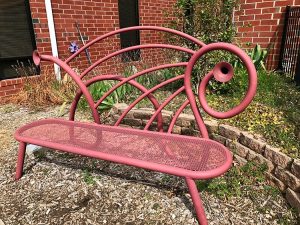 Madeline's passion and penchant for the arts run deep. Her brother, Mario Gallucci, holds a Master of Fine Arts in visual studies and lives in Portland, Oregon. Her father, Jim Gallucci, is an internationally acclaimed sculptor based in Greensboro. His large gateway pieces have transformed the Greensboro landscape, and Greensboro Montessori School is honored to have two of his “whisper benches” in the gardens flanking our front office. Madeline's mom is Dr. Kathy Gallucci, associate professor of biology at Elon University. Madeline shared she and her mom have a running joke that in their family, art is the dominant gene and science is the recessive gene. Art and science genes aside, if you saw the two side by side, you might actually wonder if they were twins.
Madeline's passion and penchant for the arts run deep. Her brother, Mario Gallucci, holds a Master of Fine Arts in visual studies and lives in Portland, Oregon. Her father, Jim Gallucci, is an internationally acclaimed sculptor based in Greensboro. His large gateway pieces have transformed the Greensboro landscape, and Greensboro Montessori School is honored to have two of his “whisper benches” in the gardens flanking our front office. Madeline's mom is Dr. Kathy Gallucci, associate professor of biology at Elon University. Madeline shared she and her mom have a running joke that in their family, art is the dominant gene and science is the recessive gene. Art and science genes aside, if you saw the two side by side, you might actually wonder if they were twins.
Like so many of our graduates, Madeline attended Greensboro Montessori School from the time she was a primary level student. “I was such an independent learner,” she said. “My parents knew that GMS was a good fit for me because I always had to do things in my own way and in my own time.” She further reflected on the values and life lessons from GMS that stick with her today. “Looking back, I realize how [the Montessori method] mirrored art school and also how it mirrors studio practice. There was always room for creativity and experimentation, and at the same time, I had to learn how to stay motivated and create my own structure and deadlines."

Madeline's work from DOUBLE TAKE, a 2016 exhibition at Terrault Contemporary in Baltimore, Maryland.
With Greensboro Montessori School's tuition payments dedicated to covering Greensboro Montessori School’s operating expenses, grants from the Annual Fund provide the necessary resources to make our School more than excellent - to make us truly exceptional. Through the benevolence of parents, alumni, community partners and friends of the School who give to the Annual Fund, Greensboro Montessori School is able to award grants biannually to teachers and students with specific classroom needs or transformative ideas or both!
Current year grants are funded by the previous year's giving. Contributions generously given and humbly received from last year's Annual Fund have begun taking shape through five grants awarded this fall. They range from simple classroom enhancements for our littlest students to significant technology investments for our elementary programs to supplies for creating a new ecosystem on campus (starring chickens) for our oldest scholars.
- Better Sleep for Growing Toddlers: The Academic-Day Toddler class received three new, high-quality Roman shades with blackout liners to help students get better sleep during nap time. While shades may seem simple to us, anything to promote sleep for our littlest students is transformative. The National Sleep Foundation says, "sleep is especially important for children as it directly impacts mental and physical development...During the deep states of [Non-Rapid Eye Movement] sleep, blood supply to the muscles is increased, energy is restored, tissue growth and repair occur, and important hormones are released for growth and development.
- Reading and Technology Resources for Lower Elementary: With four new Dell Chromebooks and a Raz-Kids subscription, the Lower Elementary program has increased access to age-appropriate, education-based technology. With dedicated laptops in the classroom, students will learn techniques for effective and safe online research and word processing skills. They will also be able to easily practice coding and have seamless access to their Raz-Kids online reading comprehension program. Furthermore, the use of PCs in Lower Elementary prepares students to be "bilingual" in the computer world. In many instances, we as adults use Apple products at home and PCs at work, or vice-versa, so ensuring our student have access to both platforms is important.
- iPads for Elementary Artists: In a continuation of Katherine Gwynn's exploration of the symbiotic relationship between creating with technology and hands-on art making, Greensboro Montessori School's art studio is now home to five iPad Airs and an iPad Pro. Students will integrate drawing, painting, digital photography, digital storytelling, animation and more through these new resources exclusive to our art curriculum.
- Chickens for Middle School Entrepreneurs: After 18 months of planning by students in the R&D (research and development) career track, the Middle School is developing a new ecosystem on campus for chickens. Working closely with Aubrey Cupit, Greensboro Montessori School's garden manager and owner of Gate City Harvest, Middle School students are building a mobile chicken coop, complete with a heat lamp, waterer and feeder for six chickens. Egg production will support the Land Lab, Maria's Café and other microeconomy programs. The coop will also include a technology cart with solar panels to power the coop's heat lamp. The mobile solar panels will also complement science lesson and provide a new power source at the Land.
- Ice for Bumps, Bruises, Food Prep, Entertaining and More: Until recently, we've been stocking our freezer with bags of ice. With a new industrial-grade ice maker, we've traded-out the ongoing cost of purchasing ice with a once-time cost to help us make it on our own (how Montessori of us)! The new ice maker supports the entire student-population ensuring a relatively unlimited supply of ice packs for minor student injuries. This resource will also keep our water and lemonade cold for guests at community events like the Fall Festival, Green & White Bash and End of the Year Pizza Party. Lastly, the Middle School will enjoy easy access to ice for Maria Café and trips to the Land.
Our fall grants are as varied as they are inspiring, but there are two things which bind them all. They are not only the result of giving, but also the reason for giving.
For everyone who has given in the past, is giving today or will give in the future, thank you for supporting Greensboro Montessori School. We are who we are because you have invested in us, and we promise to pay it forward by investing everything we can and all that we have in our students.
What do the oldest fabric in the world and a vintage typewriter have in common with my dentist? And what do they have to do with art? Well, I encountered each of them in the course of one week, and the intersection of these seemingly disparate things gave me an “a-ha” moment about the symbiotic relationship between creating with technology and hands-on art making in our School’s art studio.
As a mixed-media artist, I am naturally drawn to tactile, malleable, hands-on materials and adore using these materials in my lessons. If you walk into Greensboro Montessori School’s art studio, you will see a variety of rich textures, fibers, paints, clay, found objects and nature. You will also find a technology wall where one of the School’s 3D printers, a computers and iPads live. These two worlds co-exist harmoniously in our art studio and with each new day I am learning and teaching how technology and art are interwoven and applied in the world beyond the studio.
For instance, many Greensboro Montessori School faculty recently participated in an excellent coding workshop from Code.org. During this workshop I learned how coding is fun and creative and identified a great way to apply this technology in my classroom. Once armed with coding knowledge, students can practice their skills by writing an algorithm resulting in a specific design being drawn on their computer. They can bring this code to their art lesson and exchange it with another student. From there, students run each other’s algorithm to see if it produces what the creator originally intended.
Another project where technology and art intersect is stop motion animation. Students use a stop motion app on our classroom iPads to tell stories, but they also use physical objects make stop-motion animation the good old-fashioned way (by moving an object in small increments, taking photos of the object after each movement, and viewing multiple photos per second in a continuous sequence to create the illusion of motion). One of the most famous stop-motion animation films is the 1964 television special, Rudolph the Red-Nosed Reindeer. In our classroom, students manipulate KEVA planks, not wireframe figurines, to make their movies. The excitement has been great, and upper elementary students often rush back to class to ask Cathy Moses to come see their work!
Middle school students have been very helpful in teaching upper elementary students about the School’s 3D printer and 3D drawing program, SketchUp, which brings me back to my “a-ha” moment about the connection between art and technology. Within the course of one week at school I led a felting project demonstrating how to create with the oldest fabric in the world and guided lower elementary students in a freedom of speech exercise where they used a vintage typewriter to create art with their own words. I was reminded how each of these discoveries represented a technological shift at the time of their invention. At the end of the week, I went to the dentist and experienced a modern technology and art revolution in the making.
As crazy as it sounds, and as personal a story it is, my time at the dentist was real-world affirmation of the integration of art and technology. I was scheduled to get a crown and had anticipated my visit being the first of two required to complete the procedure, but then I was introduced to CAD/CAM (computer-aided design and computer-aided manufacturing) dentistry. While I was in the office, my dentist used technology to capture a 3D rendering of my tooth (CAD) and reproduce it onsite with a grinding and milling machine (CAM). While the grinding process used in my dentist’s office is different from the fabrication method used in 3D printing, the use of technology to produce sculpture in both cases highlights the inspirational interplay between technology and art. (And to top it all off, my ceramic crown was fired and glazed onsite, just like our students’ pottery is fired and glazed in our kiln!)
As we continue to create with our hands in collaborative and productive ways in Greensboro Montessori School's art studio, we will continue to grow the use of technology as well, because technology helps strengthen the development of our students 21st century skills and introduces them to career opportunities where art and technology co-exist.
GMS Student Art Show
Youth Art Month takes place annually, traditionally in March, to celebrate the value of art education for all children. Please join us in our celebration of the arts by attending the GMS Student Art Show & Reception on Tuesday, March 15 from 6:00 to 7:30 p.m. The art show is hosted by Mitchell & Bartlett Orthodontics, a true supporter of children's art and artists in the local community. Their office at 5314 West Friendly Avenue. This is the third year in a row that they have hosted a GMS art show. Thanks to Dr. Kelly Mitchell and her mother Sharon for being such gracious hosts.
These are just a few of the artists in Lower Elementary that will be exhibiting their work.
Lower Elementary Self Portraits
Imagination is more important than knowledge. - Albert Einstein
Upper Elementary Illuminations
Upper elementary art students have been using their art studio time to work on scenery for Medieval Faire Fare performance on Wednesday, March 23. As a result these talented artists will not be exhibiting a lot of their art work at the show. You can look forward to their art work displayed at the performance. Take a look at their Medieval illuminations they created in art.

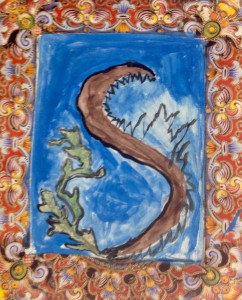
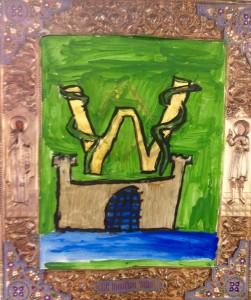
Primary Art
Primary students enjoy taking their art home right upon completion, therefore they will not have their work displayed at the art show. However, please frequent the gallery hall located outside the front office to view some of their latest printmaking works.


